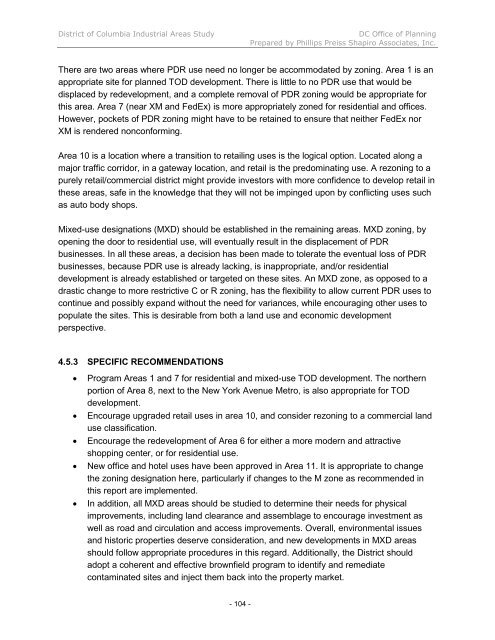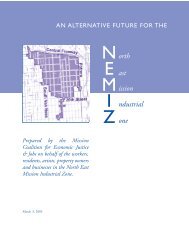INDUSTRIAL LAND IN A POST-INDUSTRIAL CITY District of ...
INDUSTRIAL LAND IN A POST-INDUSTRIAL CITY District of ...
INDUSTRIAL LAND IN A POST-INDUSTRIAL CITY District of ...
You also want an ePaper? Increase the reach of your titles
YUMPU automatically turns print PDFs into web optimized ePapers that Google loves.
<strong>District</strong> <strong>of</strong> Columbia Industrial Areas Study DC Office <strong>of</strong> Planning<br />
Prepared by Phillips Preiss Shapiro Associates, Inc.<br />
There are two areas where PDR use need no longer be accommodated by zoning. Area 1 is an<br />
appropriate site for planned TOD development. There is little to no PDR use that would be<br />
displaced by redevelopment, and a complete removal <strong>of</strong> PDR zoning would be appropriate for<br />
this area. Area 7 (near XM and FedEx) is more appropriately zoned for residential and <strong>of</strong>fices.<br />
However, pockets <strong>of</strong> PDR zoning might have to be retained to ensure that neither FedEx nor<br />
XM is rendered nonconforming.<br />
Area 10 is a location where a transition to retailing uses is the logical option. Located along a<br />
major traffic corridor, in a gateway location, and retail is the predominating use. A rezoning to a<br />
purely retail/commercial district might provide investors with more confidence to develop retail in<br />
these areas, safe in the knowledge that they will not be impinged upon by conflicting uses such<br />
as auto body shops.<br />
Mixed-use designations (MXD) should be established in the remaining areas. MXD zoning, by<br />
opening the door to residential use, will eventually result in the displacement <strong>of</strong> PDR<br />
businesses. In all these areas, a decision has been made to tolerate the eventual loss <strong>of</strong> PDR<br />
businesses, because PDR use is already lacking, is inappropriate, and/or residential<br />
development is already established or targeted on these sites. An MXD zone, as opposed to a<br />
drastic change to more restrictive C or R zoning, has the flexibility to allow current PDR uses to<br />
continue and possibly expand without the need for variances, while encouraging other uses to<br />
populate the sites. This is desirable from both a land use and economic development<br />
perspective.<br />
4.5.3 SPECIFIC RECOMMENDATIONS<br />
Program Areas 1 and 7 for residential and mixed-use TOD development. The northern<br />
portion <strong>of</strong> Area 8, next to the New York Avenue Metro, is also appropriate for TOD<br />
development.<br />
Encourage upgraded retail uses in area 10, and consider rezoning to a commercial land<br />
use classification.<br />
Encourage the redevelopment <strong>of</strong> Area 6 for either a more modern and attractive<br />
shopping center, or for residential use.<br />
New <strong>of</strong>fice and hotel uses have been approved in Area 11. It is appropriate to change<br />
the zoning designation here, particularly if changes to the M zone as recommended in<br />
this report are implemented.<br />
In addition, all MXD areas should be studied to determine their needs for physical<br />
improvements, including land clearance and assemblage to encourage investment as<br />
well as road and circulation and access improvements. Overall, environmental issues<br />
and historic properties deserve consideration, and new developments in MXD areas<br />
should follow appropriate procedures in this regard. Additionally, the <strong>District</strong> should<br />
adopt a coherent and effective brownfield program to identify and remediate<br />
contaminated sites and inject them back into the property market.<br />
- 104 -












